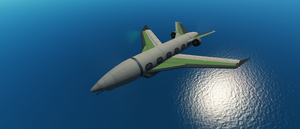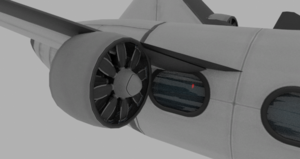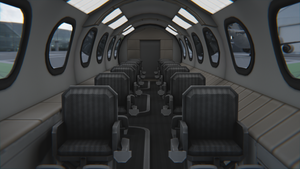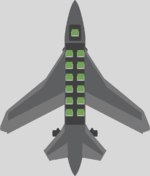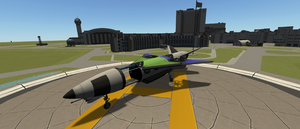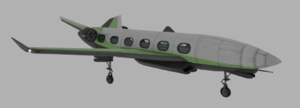C-12 Pidgeon
|
C-12
Proole C-12A "Pigeon"
|
|||||
|---|---|---|---|---|---|
| Airliner | |||||
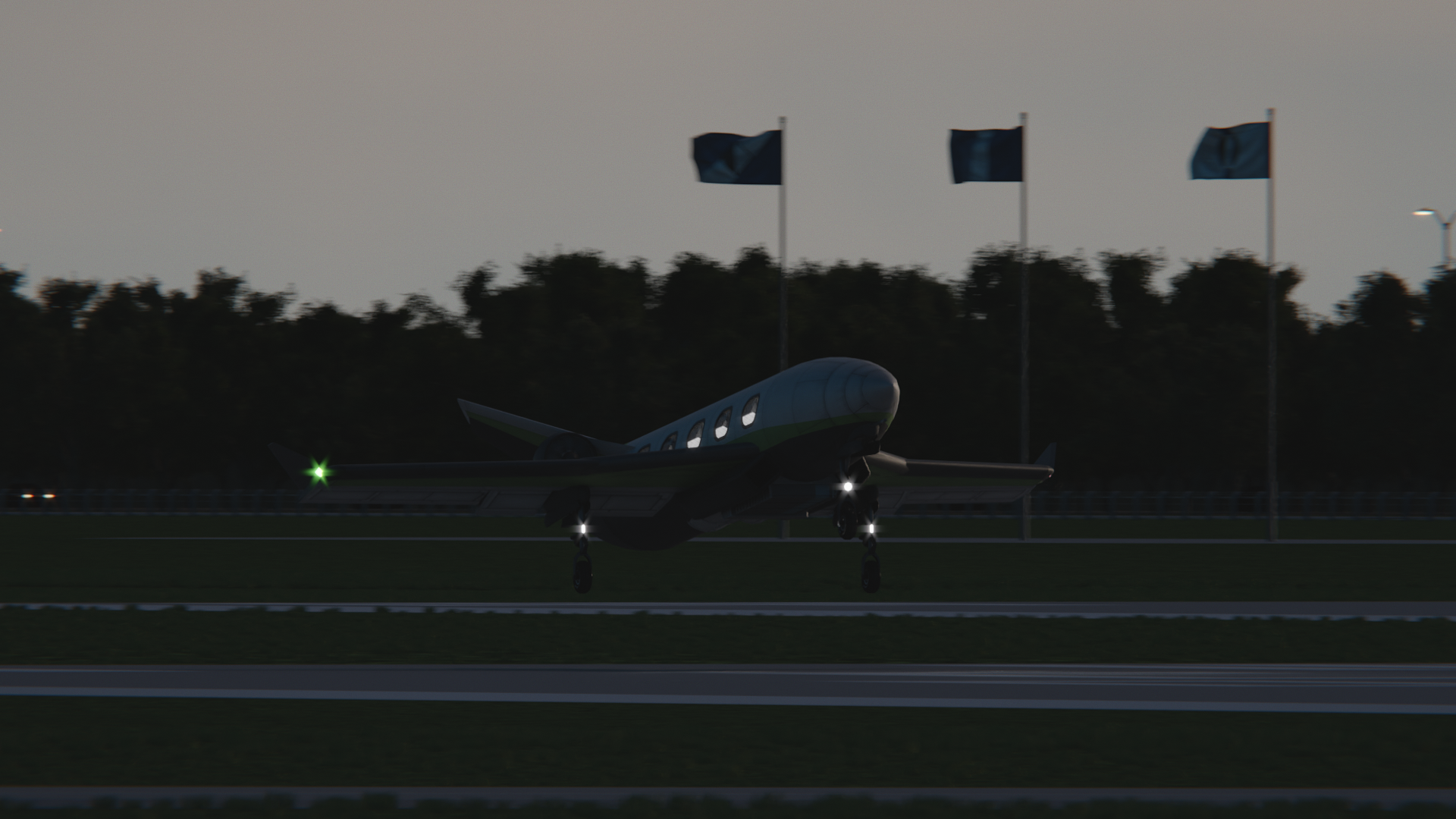 |
|||||
| A C-12 coming in to land on an airstrip in Rhudbeal | |||||
| Role | Low Volume Trans-National Carrier | ||||
| National Origin | Tekkia | ||||
| Production History | |||||
| Produced | |||||
| 2144 - 2190(Planned) | |||||
| Designer | Proole | ||||
| Unit Cost | 16,817(√) | ||||
| Number Built | 450+ | ||||
| Service History | |||||
| In Service | |||||
| 2145 - Ongoing | |||||
| Used By | Proole International Airlines Trans-Aontan Ratno Vazduhoplovstvo Kalbanije Tiare Rai | ||||
| Aircraft Characteristics | |||||
| Dry Mass | 6,584 kg | ||||
| Length | 10.6 m | ||||
| Width | 9.1 m | ||||
| Height | 1.9 m | ||||
| Propulsion | 2 x Kerman&Kerman Ambargo BG-155 Electrical Turbofan Engines | ||||
| Maximum Velocity | 94.6 | ||||
| Operational Range | 2,800 km | ||||
| Crew | Single Pilot 10-16 passenger capacity |
||||
| Variants | C-12V C-12Gr |
||||
The Proole C-12 is a turbofan-powered airliner, designed as an improved version of the successful Proole C-10 Dove. The C-12J is a vertical takeoff and landing version of the C-12. Both aircraft were manufactured and supported by Tekkian aircraft manufacturer Proole.
The C-12 was developed during the late 2120s following growing contraints on the cost of the Liquid Fuel which drove the earlier C-10 Dove. It was decided that the new airliner would be a derivative of its predecessor, sharing much of its airframe and design features, while incorporating new advances and several improvements, such as the adoption of Kerman&Kerman Ambargo BG-155 Electrical Turbofan Engines, in order to produce a successor that had a major reduction in fuel consumption.
The C-12 performed its maiden flight on 23rd August 2134 but would not enter into production until 10 years later due to Three Grestins Period within Tekkia, and entered revenue service during 2145. The C-12V variant would be developed following the success of the base model and would serve as a presidential transport for the president of Newest Grestin.
Development
C-12
By the early 2130s, the Tekkian aircraft manufacturer Proole, who had identified that sales of jet aircraft in use by both civillian sectors and the Aontas military. had been in continual production since 2044, and were beginning to incur signifigant operating costs. Accordingly, the company decided to conduct a series of design studies for follow-up products to the key elements of their existing product line. In 2121, Proole decided to commence simultaneous work on a development project to produce new aircraft, one being the C-12 Pidgeon, which was the successor to the C-10 Dove.
The C-12 was basically an amalgamation of refinements made to the C-10 platform alongside an engine change. As a result of these modificationsProole was able to progressively reduce the C-12's fuel consumption my magnitudes. Various different propeller designs were adopted over timespan of the aircraft's production, while an adjustments to the wing design, and a higher degree of cockpit automation were areas of major advances of the C-12 made over its predecessor.
Deployment Halt
Development of the C-12 would cease 2 years into the development as the onset of war within Aontas would prompt Proole to reprioritise the output of existing C-10 airframes. The partial ending of the Three Grestins Period would allow the company to slowly begin the development process. The C-12 would see its first flight on August 23rd 2139 and serial production 5 years later.
C-12V
The C-12V would be developed following the success of the C-12 platform during its production run, this variant was designed among a call for vertical capable aircraft to service high density urban areas.
Design
The Proole C-12 Pidgeon is a twin turbofan-powered airliner. It was based on the earlier highly successful C-10 Dove. Structurally owing much to its predecessor; basic construction of the fuselage, wing position, and cabin layout. There were some changes made to specific areas of the aircraft, such as the wing being equipped with wingtips that effectively acted as wing endplates or winglets, it was also fitted with a new undercarriage to support the onboard fuelcells and a new vertical stabiliser arrangement.
Perhaps the most major design change from the preceding C-10 was the choice of engines used. The original C7 Aerospace Division J-20 "Juno" Basic Jet Engines that had powered various versions of the C-10 were replaced by a pair of more fuel efficient Kerman&Kerman Ambargo BG-155 Electrical Turbofans, each capable of generating higher volumes of thrust at lower altitudes. These ducted propellers, along with other measures such as vibration absorbers, eliminate the need for active noise control systems while providing an average cabin noise level of 68 dBs.
The C-12, is furnished with a screen-based cockpit with incorporated electronic flight instrument system and an automatic flight control system, the latter being certified for conducting Cat II approaches. Within the V variant the flying controls include a unique single lever that is capable of controlling both engine power and actuating the variable-pitch fans, reducing complexity and pilot workload.
The C-12 can carry up to 24 passengers over a range of 2,800 km at a typical speed of 183 knots (94.6m/s), a decrease from the C-10. Typical passenger seating arrangements range from 12 to 24 passengers, which includes end-aisle baggage. The airliner features a single external door along with integral airstairs, which enables quicker turnaround times through the faster egress and boarding of passengers and crew alike.
The C-12 is capable of using the majority of airports worldwide, including operations from unpaved surfaces, and has been described as possessing "first-rate short field performance" and capable of performing steep approaches to access airports such as Sleibh Regional. The type has typically been marketed toward replacing older commuter and regional airliners in the 10-30 seat range. Although of possessing a design heavily dependent upon emerging technologies, the C-12 has often been highly appreciated by owners and pilots alike for its reliability, economics and flight characteristics. According to Proole, the C-12 possesses relatively low operational costs per trip and attributes this to its fuel consumption.
Variants
C-12V
The C-12V(Sometimes referred to as the C-13) is a vertical liftoff variation of the C-12 airframe. The main wings are reconfigured to support the variant's two higher power tiltrotor ducted fans. This variation also requires the rear landing gear and associated hydraulics be moved inwards. This enabled the C-12 to takeoff and land from city based heliports.
C-12Gr
The C-12Gr is a derivation of the V variant produced by special request for the State of Newest Grestin. It includes increased fuel capacity, inbuilt radar, and a reduced cabin.
Accidents and Incidents
